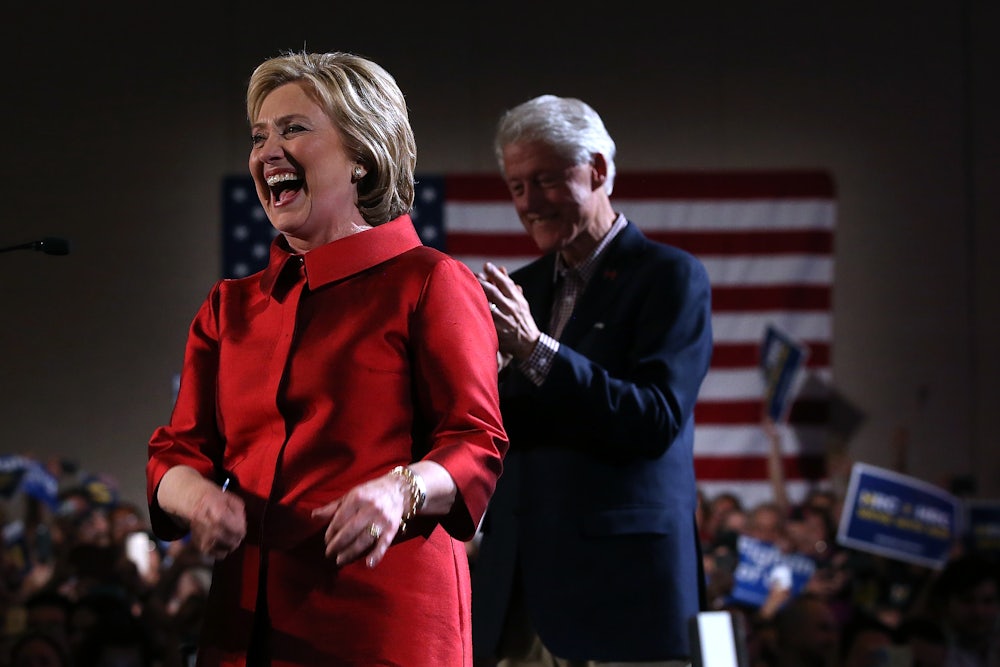Hillary Clinton needed a decisive victory in Nevada to put to rest fears that her campaign was in trouble, and it looks like she got it. At this writing, with final results still to come, it appears that she will win by four or five percentage points, basically matching her 2008 win in the state over Barack Obama. With this victory, Clinton has a clear path for pushing aside her too-close win in Iowa and big loss in New Hampshire. She can plausibly argue that Bernie Sanders’s coalition is too narrow—that it is, in particular, too heavily white—to reflect the Democratic Party, which after all is a multi-racial coalition.
And she’s clearly aiming to broaden her own coalition. In her victory speech, Clinton incorporated many of the themes of Sanders’s campaign, emphasizing economic populist messages like student debt. She also made sure to note (a la Sanders) that most of her funding comes from small donors contributing less than $100. And throughout the speech, she repeatedly used the communitarian “we”—a response perhaps to criticism that her campaign has been too much about her leadership and experience, and not enough about common purpose.
If this win is followed by Clinton’s expected victory in next Saturday’s South Carolina primary and the six Southern states of Super Tuesday on March 1, she has a clear path to racking up enough delegates to be the prohibitive front-runner, especially in light of her strong lead among the Democratic super-delegates. The irony is that Clinton might end up making the same argument from delegate math that Obama made in 2008. If Clinton wants to wrap up the primary early, she could soon be in a position to argue that the delegate math overwhelmingly favors her—and Sanders would have to make the same argument that Clinton did in 2008, when Obama took the lead, that every voter needs to be heard from and that he could still conceivably win a majority of votes going forward.
The news isn’t entirely bleak for Sanders. He doesn’t have as clear a path out of Nevada, but he has done better in the state than he could’ve been expected to do even a few weeks ago. By all logic, a state where the demographics trend both older and non-white should have been a bigger Clinton blow-out. Even as the Clinton campaign will likely gather force in the Southern states, Sanders can still make a credible showing in other Super Tuesday states like Colorado, Massachusetts, and Minnesota. In theory, if he does well enough in those states he can make the race tighter again nationally, especially if the inroads he appeared to make among young Latinos in Nevada can be replicated elsewhere.
But just how well Sanders actually did with Latinos in Nevada is murky. Entrance polls showed Sanders winning Latinos, but these results are suspect given the fact that he lost the race. What’s more plausible is that he was at least competitive with Latinos, given the margin of the final vote—heartening for Sanders, but hardly convincing proof that he’s made the breakthrough with non-white voters that he needs.
Ultimately, the harder part for Sanders going forward will be crafting a plausible narrative. Coming out of Nevada, Clinton can reasonably argue that she won in a state that looks much more like the Democratic coalition than largely white states like Iowa and New Hampshire. Clinton has the support of women (although it’s not clear if she won young women in Nevada after losing them in New Hampshire), African-Americans, and Latinos. That is close to the coalition that Obama used to win two elections in a row. The only thing missing from the equation is the enthusiasm of young people, which Sanders still has.
As the challenger, Sanders has the more difficult task of proving that he can both bring in new voters and appeal to loyal Democrats. So far, Sanders has been more successful at the first half of the equation. And unless he can make genuine inroads among African-Americans and improve with Latinos above what he’s achieved in Nevada, it’ll be hard to for him to argue that he represents the broader Democratic Party. Even a self-professed revolutionary has to work with the existing party before he or she can expand it. Sanders remains a viable candidate, but coming out of Nevada he faces the bigger burden of forging a winning coalition.
